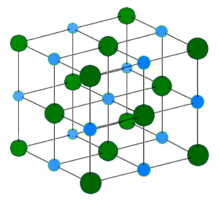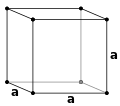Cubic crystal system
The cubic crystal system (or isometric) is a crystal system where the unit cell is in the shape of a cube. This is one of the most common and simplest shapes found in metallic crystals.
Bravais lattices and point/space groups
The three Bravais lattices which form the cubic crystal system are
-
Simple cubic
-
Body-centered cubic
-
Face-centered cubic
The simple cubic system consists of one lattice point on each corner of the cube. Each atom at the lattice points is then shared equally between eight adjacent cubes, and the unit cell therefore contains in total one atom (1/8 * 8). The body centered cubic system has one atom in the center of the unit cell in addition to the eight corner points. It has a contribution from 2 atoms per cell ((1/8)*8 + 1). Finally, the face centered cubic has atoms on the faces of the cube of which each unit cube gets exactly one half contribution, giving a total of 4 atoms per unit cell ((1/8 for each corner) * 8 corners + (1/2 for each face) * 6 faces). There are 8 lattice points on a simple cubic for each corner of the shape. There are 9 lattice points for a body centered because of the extra point in the center of the unit. There are 14 lattice points on a face centered cubic.
The point groups and space groups that fall under this crystal system are listed below, using the international notation.
| Point group | # | Cubic space groups | |||||||
| 195-199 | P23 | F23 | I23 | P213 | I213 | ||||
| 200-206 | Pm | Pn | Fm | Fd | I | Pa | Ia | ||
| 207-214 | P432 | P4232 | F432 | F4132 | I432 | P4332 | P4132 | I4132 | |
| 215-220 | P3m | F3m | I3m | P3n | F3c | I3d | |||
| 221-230 | Pmm | Pnn | Pmn | Pnm | Fmm | Fmc | Fdm | Fdc | |
| Imm | Iad | ||||||||
There are 36 cubic space groups, of which 10 are hexoctahedral: Fd3c, Fd3m, Fm3c, Fm3m, Ia3d, Im3m, Pm3m, Pm3n, Pn3m, and Pn3n. Other terms for hexoctahedral are normal class, holohedral, ditesseral central class, galena type.
Atomic packing factors and examples
The cubic crystal system is one of the most common crystal systems found in elemental metals, and naturally occurring crystals and minerals. One very useful way to analyse a crystal is to consider the atomic packing factor. In this approach, the amount of space which is filled by the atoms is calculated under the assumption that they are spherical.
Single-element lattices
Assuming one atom per lattice point, the atomic packing factor of the simple cubic system is only 0.524. Due to its low density, this is a high energy structure and is rare in nature, but is found in Polonium [1]. Similarly, the body centered structure has a density of 0.680. The higher density makes this a low energy structure which is fairly common in nature. Examples include iron, chromium, and tungsten.
Finally, the face centered cubic crystals have a density of 0.741, a ratio that it shares with several other systems, including hexagonal close packed and one version of tetrahedral BCC. This is the most tightly packed crystal possible with spherical atoms. Due to its low energy, FCC is extremely common, examples include lead (for example in lead(II) nitrate), aluminum, copper, and gold.
Multi-element compounds

Light blue = Na+ (Sodium ion)
Dark green = Cl− (Chloride ion)
When the compound is formed of two elements whose ions are of roughly the same size, they have what is called the interpenetrating simple cubic structure, where two atoms of a different type have individual simple cubic crystals. However, the unit cell consists of the atom of one being in the middle of the 8 vertices, structurally resembling body centered cubic. The most common example is caesium chloride CsCl.
However, if the cation is slightly smaller than the anion (a cation/anion radius ratio of 0.414 to 0.732), the crystal forms a different structure, interpenetrating FCC. When drawn separately, both atoms are arranged in an FCC structure. The unit cell for this is shown to the left.
See also
- Reciprocal lattice
- Atomium: building which is a model of a bcc unit cell, with vertical body diagonal.
- Dislocations
References
- Hurlbut, Cornelius S.; Klein, Cornelis, 1985, Manual of Mineralogy, 20th ed., Wiley, ISBN 0-471-80580-7
- ^ Greenwood, Norman N.; Earnshaw, Alan (1997). Chemistry of the Elements (2nd ed.). Butterworth-Heinemann. ISBN 978-0-08-037941-8.










